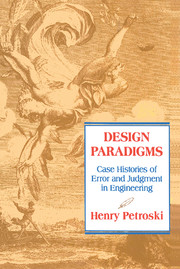Book contents
- Frontmatter
- Contents
- Preface
- 1 Introduction
- 2 Paconius and the Pedestal for Apollo
- 3 Vitruvius's Auger and Galileo's Bones: Paradigms of Limits to Size in Design
- 4 Galileo and the Marble Column
- 5 Galileo's Confirmation of a False Hypothesis
- 6 The Design and Collapse of the Dee Bridge
- 7 The Britannia Tubular Bridge
- 8 Failure as a Source of Engineering Judgment
- 9 The Design Climate for the Tacoma Narrows Bridge
- 10 Historic Bridge Failures and Caveats for Future Designs
- 11 Conclusion
- Bibliography
- Index
4 - Galileo and the Marble Column
A Paradigm of a Design Change for the Worse
Published online by Cambridge University Press: 05 June 2012
- Frontmatter
- Contents
- Preface
- 1 Introduction
- 2 Paconius and the Pedestal for Apollo
- 3 Vitruvius's Auger and Galileo's Bones: Paradigms of Limits to Size in Design
- 4 Galileo and the Marble Column
- 5 Galileo's Confirmation of a False Hypothesis
- 6 The Design and Collapse of the Dee Bridge
- 7 The Britannia Tubular Bridge
- 8 Failure as a Source of Engineering Judgment
- 9 The Design Climate for the Tacoma Narrows Bridge
- 10 Historic Bridge Failures and Caveats for Future Designs
- 11 Conclusion
- Bibliography
- Index
Summary
Galileo begins the first day of Dialogues Concerning Two New Sciences by relating several stories of contemporary structural failures that were inexplicable within the state of the art of Renaissance engineering. As indicated in the last chapter, several of the stories have to do with the problem of proportionately similar structures behaving differently depending upon whether they are large or small, hence manifesting a scale effect. According to Galileo,
Thus, for example, a small obelisk or column or other solid figure can certainly be laid down or set up without danger of breaking, while the very large ones will go to pieces under the slightest provocation, and that purely on account of their own weight.
Such generalizations could, of course, be reached by experience alone, and there were no doubt even rules of thumb as to how large an obelisk or column had to be to require special care in its storage or erection. Empirical evidence of failure and rules of thumb were not sufficient to explain why a failure would occur, of course, but they could certainly help avoid failures in situations recognized to be precarious. Indeed, with little more than an empirical understanding of what worked and what could go wrong when the untried was tried, Renaissance designers might have been particularly cautious in their attempts to extrapolate to larger structures and ever attentive to situations that might lead to failure.
- Type
- Chapter
- Information
- Design ParadigmsCase Histories of Error and Judgment in Engineering, pp. 47 - 63Publisher: Cambridge University PressPrint publication year: 1994



